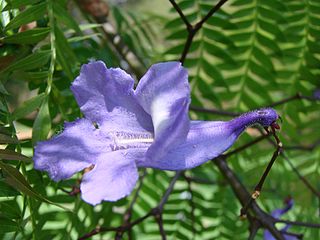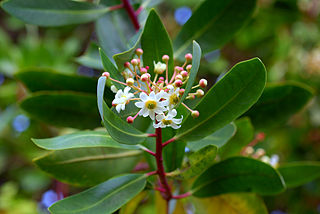
Psidium is a genus of trees and shrubs in the family Myrtaceae. It is native to warmer parts of the Western Hemisphere.

Alstroemeriaceae is a family of flowering plants, with 254 known species in four genera, almost entirely native to the Americas, from Central America to southern South America. One species of Luzuriaga occurs in New Zealand, and the genus Drymophila is endemic to south-eastern Australia.

Jacaranda is a genus of 49 species of flowering plants in the family Bignoniaceae, native to tropical and subtropical regions of the Americas.

Drimys is a genus of about eight species of woody evergreen flowering plants, in the family Winteraceae. The species are native to the Neotropics, ranging from southern Mexico to the southern tip of South America. They are primitive dicots, associated with the humid temperate Antarctic flora of the Southern Hemisphere, which evolved millions of years ago on the ancient supercontinent of Gondwana. Members of the family generally have aromatic bark and leaves, and some are used to extract essential oils.

Tabernaemontana is a genus of flowering plants in the family Apocynaceae. It has a pan-tropical distribution, found in Asia, Africa, Australia, North America, South America, and a wide assortment of oceanic islands. These plants are evergreen shrubs and small trees growing to 1–15 m tall. The leaves are opposite, 3–25 cm long, with milky sap; hence it is one of the diverse plant genera commonly called "milkwood". The flowers are fragrant, white, 1–5 cm in diameter.

Porophyllum is a genus of flowering plants in the marigold tribe within the daisy family known commonly as the poreleaf genus.

Pera is a genus of the flowering plant family Peraceae, first described as a genus in 1784. It is native to tropical America, from southern Mexico and the West Indies south as far as Paraguay.

Desmoncus is a genus of mostly climbing, spiny palms native to the Neotropics. The genus extends from Mexico in the north to Brazil and Bolivia in the south, with two species present in the southeastern Caribbean.

Micropholis is group of trees in the family Sapotaceae, described as a genus in 1891.

Marcgravia is a genus of plants in the Marcgraviaceae family commonly eaten by the dwarf little fruit bat the plant is native to the Caribbean Islands, Central America, and South America. The genus is named in memory of the German naturalist Georg Marcgraf. The plant is visited by Thomas's nectar bat.

Roupala is a Neotropical genus of woody shrubs and trees in the plant family Proteaceae. Its 34 species are generally found in forests from sea level to 4000 m altitude from Mexico to Argentina.

Thevetia is a genus of flowering plants in the family Apocynaceae, first described for modern science as a genus in 1758. It is native to Mexico, Central America, South America, and Cuba. The taxonomy of the genus is controversial, with some authors including Cascabela within Thevetia, while others accept the two genera as separate.

Acrocomia is a genus of palms which is native to the Neotropics, ranging from Mexico in the north, through Central America and the Caribbean, and through South America south to Argentina.

Bixa is a genus of plants in the family Bixaceae. It is native to Mexico, Central America, Caribbean, and South America, and naturalized in other places.

Richardia brasiliensis is a species of flowering plant in the coffee family known by the English common names tropical Mexican clover, Brazilian calla-lily, white-eye, and Brazil pusley. In Brazil it is known as poaia branca. It is native to South America. It is an introduced species and sometimes an invasive weed in many other places, including Hawaii, Indonesia, Japan, and Thailand. It is a weed of citrus groves in Florida.

Richardia scabra, commonly called rough Mexican clover or Florida pusley, is a species of flowering plant in the family Rubiaceae. It is widespread, native to warm areas of both North America and South America. In the southeastern United States, it is often found in disturbed habitats.

Bia is a genus of plant of the family Euphorbiaceae first described as a genus in 1841. The entire genus is native to South America.
- Bia alienataDidr. - Brazil, Bolivia, Paraguay, N Argentina
- Bia capivarensisMedeiros & Alves - Serra da Capivara
- Bia fallax(Müll.Arg.) G.L.Webster - Peru, Rondônia
- Bia fendleri(Müll.Arg.) G.L.Webster - Guyana, Venezuela, Amazonas State of Brazil
- Bia lessertianaBaill. - Fr Guiana, Suriname, Guyana, N Brazil
- Bia manueliiV.W. Steinm. & Ram.-Amezcua, 2013, Sierra de Coalcomán, Michoacán, Mexico

The Solanaceae, or nightshades, are a family of flowering plants that ranges from annual and perennial herbs to vines, lianas, epiphytes, shrubs, and trees, and includes a number of agricultural crops, medicinal plants, spices, weeds, and ornamentals. Many members of the family contain potent alkaloids, and some are highly toxic, but many—including tomatoes, potatoes, eggplant, bell and chili peppers—are used as food. The family belongs to the order Solanales, in the asterid group and class Magnoliopsida (dicotyledons). The Solanaceae consists of about 98 genera and some 2,700 species, with a great diversity of habitats, morphology and ecology.


















